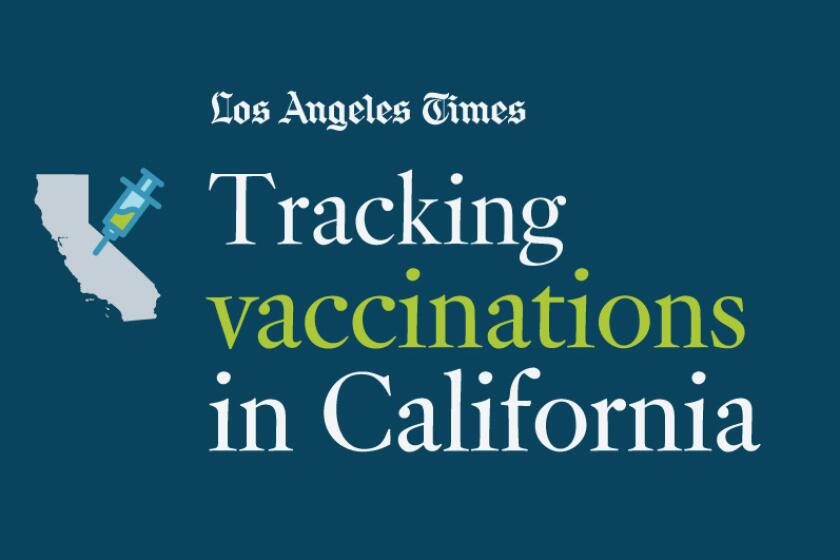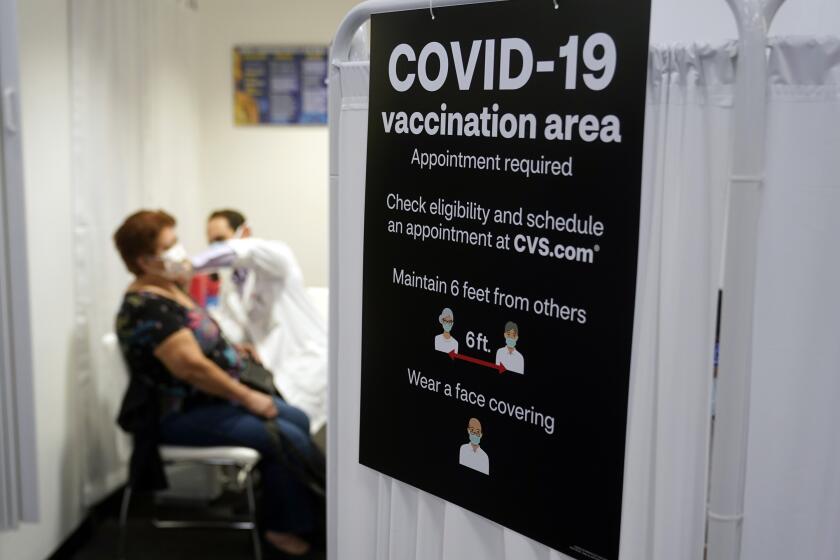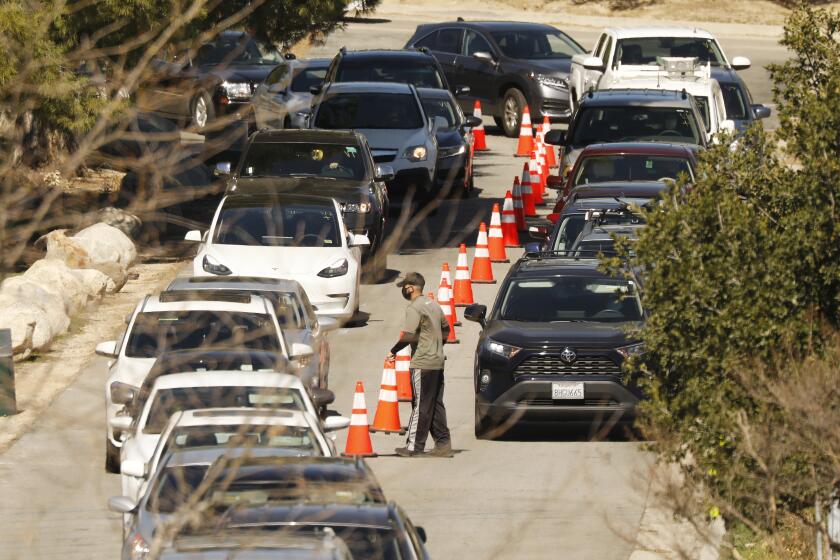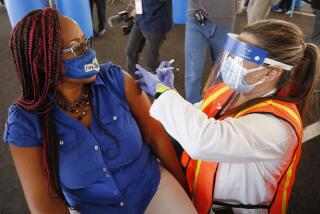Orange County and other California sites to close mass COVID-19 vaccination centers
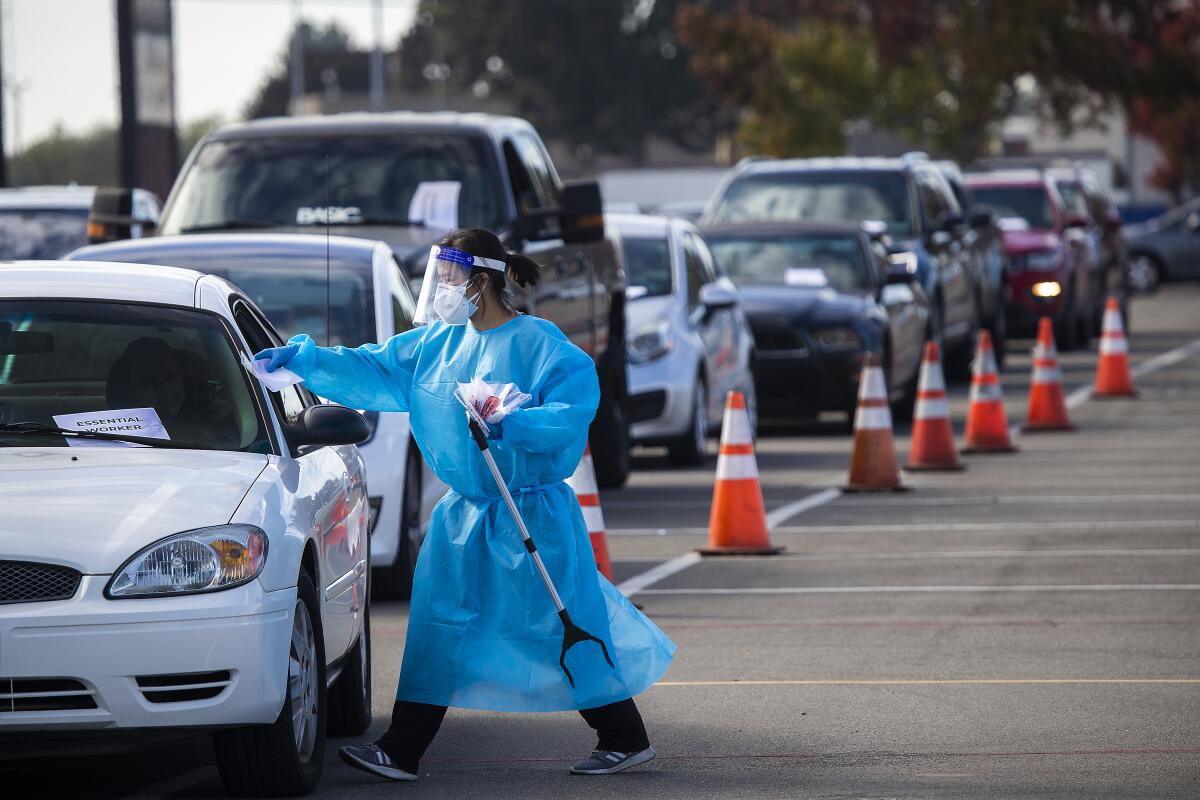
- Share via
Officials in Orange County and elsewhere in California are preparing to close a number of COVID-19 mass vaccination sites as bookings for appointments continue to drop dramatically and authorities look to shift doses to mobile vaccine clinics, pharmacies and doctor’s offices.
Orange County officials said the demand for first doses has dropped by over 75% since the end of April. As a result, efforts will be made to boost vaccine clinics in neighborhoods. The county said that on June 6, it will close mass vaccination sites at the Anaheim Convention Center, OC Fair & Event Center, Soka University and Santa Ana College.
The last first-dose Moderna appointments will be offered Saturday, and the last first-dose Pfizer appointments will be offered May 15.
“Vaccine supply has become more plentiful, and alternative distribution channels, such as local pharmacies, hospitals, healthcare systems, community clinics and providers are more actively administering doses,” county officials said.
The announcement came a day after officials decided to close the Oakland-Alameda Coliseum mass vaccination site, which will shut down May 23. Requests for first doses have dropped from 4,000 a day to 400, according to the Alameda County Public Health Agency. Focus on vaccine distribution there will also shift to smaller clinics.
Last week, Los Angeles city officials said the mass vaccination site at Dodger Stadium — one of the largest in the country — will stop operations by the end of May.
Experts say about most Americans will need to be vaccinated to bring the coronavirus pandemic under control. Track California’s progress toward that goal.
Experts have long expected the demand for vaccinations would slow as people who are most willing get the shots. Officials say that getting the remainder of the nation vaccinated will be harder, and focus needs to be on lower-income populations and vulnerable people who are unable to drive long distances or have limited time to get a shot.
“We are going to make it as easy as possible for every American to get a vaccine,” Andy Slavitt, a senior Biden administration advisor on the pandemic, told reporters recently. He said Americans can text their ZIP code to 438829 and receive a reply with the three locations nearest them with vaccines in stock. Spanish speakers can text their ZIP code to 822862. Slavitt said Uber and Lyft are offering free or discounted rides for vaccine recipients.
The recent drop-off in interest in getting vaccines has worried public health officials. In L.A. County, the average number of vaccine doses administered daily fell to about 67,000 last week, down 23% from the previous week’s daily average of 87,000.
Similar declines were seen elsewhere. Santa Clara County’s average daily doses administered last week fell to about 20,000, down from the previous week’s 30,000 a day. San Francisco‘s average daily doses fell to 7,000 last week, down from 10,000 a day the previous week.
Local health officials across California say they still need to do more to improve access to the vaccines for difficult-to-reach populations, such as expanding weekend and evening hours for working people, doing more at-home vaccination visits, allowing drop-in visits to vaccine clinics without appointments and offering transportation to vaccine sites.
After early success, U.S. vaccination rates have dropped by a third in the last three weeks, challenging Biden’s effort to end the pandemic.
Researchers have found that the vast majority of Latinos are willing to get vaccinated, but the challenge is primarily an issue of access and making it easy to get the shot, Dr. Tomás Aragón, the director of the California Department of Public Health and state health officer, told a hearing of the state Assembly Emergency Management Committee on Tuesday. Among some Black residents, there’s less willingness to get vaccinated, so efforts need to be made “to build trust with the African American community,” Aragón said.
Black and Latino residents have been hit disproportionately hard by the pandemic.
A Kaiser Family Foundation survey found that majorities of Black and Latino residents in most age groups nationally either have received at least one dose of vaccine or want to get vaccinated as soon as possible. One exception, however, is among Black residents ages 18 to 49, where 27% say they would either definitely not get the shot or only get it if required, and 24% said they would wait and see. The remaining 45% had either received the vaccine or wanted to get vaccinated as soon as possible.
One issue holding them back may be lack of good information. An estimated 42% of Latino adults reported not being sure whether they’re currently eligible to get a COVID-19 vaccine in their state, and 45% of Latino adults didn’t have enough information about when they get a vaccine — rates that are far higher than for Black and white adults.
Aragón said he’s working on a new vaccine equity plan, focusing on 13 counties in places like the Inland Empire and San Joaquin Valley, where the goal will be to boost vaccination rates in the most disadvantaged communities of the state. Those counties are likely to include Riverside and San Bernardino counties in Southern California, and in the San Joaquin Valley, Fresno, Kern, Madera, Merced, San Joaquin, Stanislaus and Tulare.
Providers throughout Los Angeles County administered 144,000 fewer COVID-19 vaccine doses last week compared with the week prior — the clearest evidence yet that the demand for doses has dropped significantly.
Some of the counties with the lowest vaccination rates are in the Central Valley and the rural far northern part of California. In the San Joaquin Valley, only 26% of Kings County residents have received one shot, and in Kern and Merced counties, 33%. Some farmworkers working grueling schedules still haven’t received vaccinations.
“At this point, it’s really about getting hyperlocal,” Aragón said. As an example, he pointed out efforts in San Francisco’s heavily Latino Mission District, where priests speaking at a Spanish Mass at St. Peter Church asked whether those in attendance had been vaccinated. For those who hadn’t and were interested, a team of public health staffers was available after worship services to get them registered for an appointment.
Close by, Aragón said, a vaccine clinic at the subway station at 24th and Mission streets had staff on hand to talk to vaccine recipients, encouraging them to tell family members who hadn’t been vaccinated to get the shot. “Community members that are getting vaccinated … can go home and bring [unvaccinated] people back,” Aragón said.
San Francisco has one of the best vaccination rates in the state, with 65% of residents having received at least one shot. In L.A. County, 48% of residents have received at least one dose.
Santa Clara County is also working with unions to get vaccines into the arms of hotel, janitorial and security workers, as well as employers to target workers in food and restaurant service, construction and retail. Officials there have targeted specific census tracts with low vaccination rates that are also home to high-risk residents, sending workers to canvass the area and then setting up pop-up vaccine clinics.
Plans underway in Silicon Valley include student vaccination nights at Levi’s Stadium, large sports advertising efforts to reach men, and more mobile clinics to reach low- and middle-income workers.
“Getting these vaccines needs to be both easy and convenient,” Nick Macchione, director of the San Diego County Health and Human Services Agency, told the county’s Board of Supervisors on Tuesday.
More to Read
Sign up for Essential California
The most important California stories and recommendations in your inbox every morning.
You may occasionally receive promotional content from the Los Angeles Times.
